The Sony SmartWatch is an intriguing device — a secondary display for your Android-powered handset that provides quick access to notifications from select apps and services on your phone. It’s also able to show you who's calling or texting, control music, and even tell the time. There's been a growing trend for products like this over the past few months, from the WIMM One to Fossil’s MetaWatch, but Sony’s is one of the first of this latest wave (along with the inPulse) to make it to the general public.
Sony’s range of LiveWare accessories certainly offer a unique take on connected headsets and wearable interfaces for your Android phone, but they've previously been hit-and-miss-affairs, generally seen as great ideas that don’t quite fulfil their promise. The SmartWatch is the latest in this line, a follow-up to the LiveView that was released around a year and a half ago. The older model offered similar features, but was critically panned for being unresponsive, unreliable, and utterly useless if it lost connection with the phone. Sony has made plenty of changes in this iteration, but the price went up too — the SmartWatch comes in at $149.99, almost double the $79.99 of its predecessor. Are phone-connected watches finally growing up, and is the SmartWatch worth the extra cash? Read on to find out.
Hardware / design
Hardware / design
Well built, charming, and less bulky than you'd think
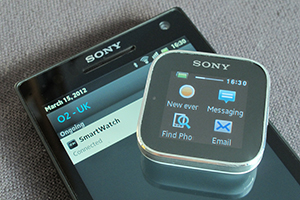
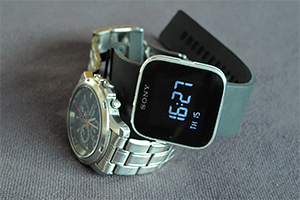

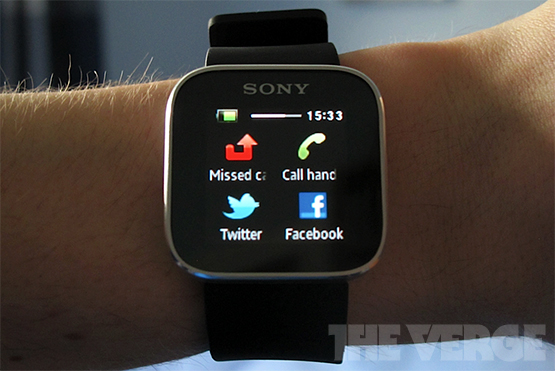
The SmartWatch’s main feature is a 1.3-inch OLED display fitted into a case reminiscent of the sixth-generation iPod nano, measuring 1.5 inches across its square face, and a half-inch high when locked into the integrated clip. A power button is placed where you’d find the crown winder of an analog watch, and a Sony logo is printed on the bezel beneath the glass face. There’s an obvious distinction between the bezel and the display, which is slightly disappointing — it breaks up the otherwise glossy black face when the backlight is switched off.
An aluminum frame wraps around the edge of the display, broken only by the aforementioned power button, and the sprung clip and bottom casing are made of white plastic. Underneath the clip are four golden metal contacts, used to charge the device with a proprietary USB cable. This is a neat design in that there aren’t any flaps or exposed ports on the device, though if you lose or break the cable it could be difficult to find a replacement.
The display itself is bright, clear, and astonishingly sharp, though its low 128 x 128 resolution makes images and text grainy and jagged. The color depth is decent, especially for something so small — Sony’s specs say that it’s capable of showing 65,000 colors — but it's difficult to look for detail in the color amidst the pixel noise.
The included strap doesn't quite do it justice
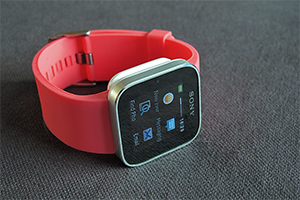
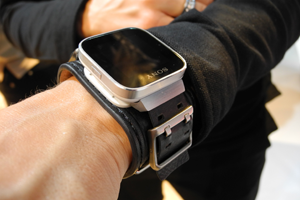
The SmartWatch interface is now fully touch-based, rather than relying on the bezel controls that made for an imprecise and frustrating experience in the LiveView. The capacitive panel supports two-finger multitouch and is largely responsive, although there’s some occasional lag or missed gestures. The glass feels built to last, but it's a real fingerprint magnet, and you’ll frequently find yourself wiping away oily marks from its face. It turns on via the the power button, or a vibration sensor — shake or tap the watch and it’ll display the time.
A black rubber watchband adapter ships with the SmartWatch, with the Sony logo etched into the metal fastener. A molded dip holds the watch in place, reinforced by what feels like a metal core. We also received a pink version with our review unit, and saw a number of other colors at MWC. The strap’s comfortable, even on my slim wrists, which is helped by the meagre weight of the watch unit. However, while the band feels durable, it’s not particularly stylish — thankfully Sony's also got an adapter on the way that will allow you to use any strap you choose.
Software
It shouldn't be this tough to configure
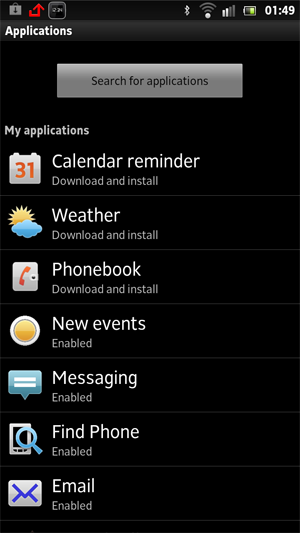


The watch uses Bluetooth 3.0 to connect to your phone, and is designed solely for use with Android handsets, specifically with Sony’s Xperia line, though a smattering of phones from other manufacturers are also supported — a full list is available on Sony’s website. Out of curiosity, I tried using the SmartWatch with my HTC Desire running MIUI (admittedly not one of the handsets listed as recommended) using the apps available from Google Play, and found that it couldn’t maintain a reliable connection with the watch.
I also tried connecting it to the Sony Xperia S, one of the phones described as a "perfect partner" to the SmartWatch. Having charged the watch, I paired the handset via Bluetooth, followed the prompts to install the software needed, and upgraded the watch to the latest firmware. So far, so simple.
Here’s where it gets frustrating: configuring and adding apps to the SmartWatch is an unnecessarily laborious process. The only preinstalled app is the Events widget — an aggregator of everything else sent to the watch. To install more apps, you’re directed to the Android Market (now the Play Store) to download and install each and every one. Once you’ve added an app, you head back to the SmartWatch configuration pane, which is present in your Android notification tray whenever the watch is connected. From there, you can configure the downloaded watch app’s behavior, what accounts to use, whether it should show as a widget, and so on. The whole process is just needlessly complex. Since it’s a totally proprietary system, it seems strange that Sony hasn’t created its own method of adding apps to the device, when offering one-click installations would be much simpler. It's worth mentioning that I was using a preview version of the watch, so this software might be updated by launch, but as things stand it's overly complicated.
Usability
Once you’ve gotten past the configuration process, you can finally use the watch itself. There’s a moment of real geeky glee when you first start using it — anyone who grew up watching Star Wars or Power Rangers is bound to have images of using the SmartWatch as a communicator as you see data beginning to appear on the device. Over 40 apps are available for the watch (mainly from third-party developers), offering the core functions you’d expect like call handling, text messaging, music controls, Facebook, and Twitter. There are also a few surprises: the remote viewfinder app is especially impressive, showing the output of the phone’s camera on the tiny display and allowing you to focus and trigger the shutter. It's a neat trick, though I can’t imagine too many situations where it’d come in useful.
Clean and tidy, but boy is it unintuitive
Most watch apps have two views: a full-screen mode and a widget, the latter offering the most recent piece of information at a glance. Full apps generally offer more depth — you can read whole tweets or Facebook status updates, for example — though any input from you is limited to one preset, which you edit from the phone.
Apps alert you to notifications by vibrating the device and displaying a logo on the screen showing which app has something new. It’s not as interactive as you might expect, though — tapping on the notification doesn’t send you to the latest tweet or missed call, leaving you to navigate through the menus to get to whatever needs your attention.

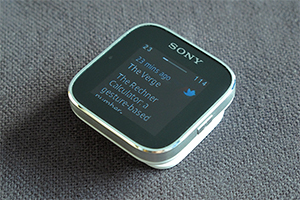
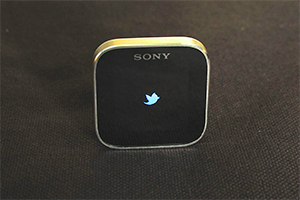
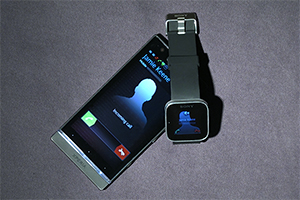
The interface itself has a definite learning curve. Navigation is far from intuitive, with some of the gestures to control the device and the logic behind the system feeling almost arbitrary. The primary view is a digital watch face with date in one corner — tap that and you’re taken to the most recent screen. Tapping with two fingers will take you up a level in the menu system. These taps and swipes eventually become second nature, but I was left confused for a few minutes as I tried to find the apps that I’d just installed — your widgets are the default view.
One area the device has obvious potential in is sports, though the only fitness-related app right now is Google Tracks. Sony's promised that a partner app for Endomondo Sports Tracker is on the way, which will offer your time and calories burned, and is aiming to have it available when the SmartWatch launches. A big issue for almost any Android user is also the lack of Gmail integration — a third-party app will notify you if you get an email, but won’t show you the sender or subject. This is a limitation of the Gmail app itself, but it definitely affects the usefulness of the watch.
The SmartWatch is still able to tell the time even if it loses connection with your phone, a critical upgrade from the LiveView. Following an initial sync, the time is memorized for as long as the watch has power, and you’re no longer left with a useless weight mounted on your wrist when your phone isn't connected.
Sony claims that the watch can manage 3-4 days in constant use before recharging, or up to two weeks while on standby. My testing gave me no reason to question this, and your phone’s battery will undoubtedly die long before the watch.
A neat idea, but it's tough to escape the novelty value
The SmartWatch is an unusual product — it’s definitely made for a niche of users, and feels like the spiritual successor to the calculator and TV remote watches of the 80s and 90s. It’s clear that this niche exists, though, with a number of manufacturers making products designed to to make your phone’s critical information available at a glance.
The SmartWatch definitely has its charms — in situations where reaching for your phone is either awkward or unsafe, being able to see who’s calling or texting you can be invaluable. It’s bulkier than most watches, but not enough for you to feel conscious of it. The SmartWatch is certainly a huge improvement over Sony’s previous LiveWare offerings, and directly addresses many of the irritations of the LiveView. It’s also a great piece of geek chic, and is in its own way an attractive product.
A couple of issues do really stand out, though, especially the price. The extra $60 over the LiveView is largely explained by the improvements to the screen and materials, but $149.99 is a hefty chunk of change for something that’s a novelty for most people. Secondly, while the app selection is wider than I expected, with a niche product like this it could be an uphill struggle to get support from major developers. Its functionality is also inherently limited, with each of the apps providing only a few features and often forcing you to pull out your phone to react. The concept shows potential, but the SmartWatch doesn’t quite reach it.
:format(webp)/cdn.vox-cdn.com/uploads/chorus_asset/file/12796619/Sony_SmartWatch_Review12_1020.1419966167.jpg)
:format(webp)/cdn.vox-cdn.com/uploads/chorus_asset/file/12796619/Sony_SmartWatch_Review12_1020.1419966167.jpg)
Share this story